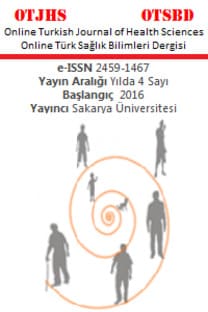COVID-19 Korkusu ile Aşı Olma Niyeti Arasındaki İlişkide Mikroptan Kaçınmanın Aracılık Rolü
COVID-19, Korku, Mikroptan Kaçınma, Aşı, Yapısal Eşitlik Modellemesi
The Mediating Role of Germ Aversion in the Relationship between Fear of COVID-19 and Intention to Vaccinate
COVID-19, Fear, Germ Aversion, Vaccine, Structural Equation Modeling,
___
- 1. Parıldar H, Dikici MF. History of pandemics. Journal of Clinical Medicine Family Medicine, 2020;12(1):1-8.
- 2. Artan T, Karaman M, Atak I, Cebeci F. Evaluation of the scale of assessment of perceptions and attitudes towards the COVID-19 outbreak. Journal of Social Work. 2020;4(2):101-107.
- 3. T.R. Ministry of Health. COVID-19 guide 2020. https://covid19.saglik.gov.tr/. Accesed August 1, 2021.
- 4. World Health Organization. Coronavirus disease (COVID-19). https://www.who.int/publications/m/item/weekly-operational- update-on-covid-19. Accesed August 18, 2021.
- 5. Tian H, Liu Y, Li Y, et al. An investigation of transmission control measures during the first 50 days of the COVID-19 epidemic in China. Science. 2020;368:638–642. doi:10.1126/science.abb6105
- 6. Wibawa T. COVID‐19 vaccine research and development: ethical issues. Tropical Medicine & International Health. 2021;26 (1):14-19. doi:10.1111/tmi.13503
- 7. Abbas KM, Kang GJ, Chen D, Werre SR, Marathe A. Demographics, perceptions, and socioeconomic factors affecting influenza vaccination among adults in the United States. PeerJ. 2018;6(2), e5171. doi:10.7717/peerj.5171.
- 8. Almario CV, May FP, Maxwell AE, Ren W, Ponce NA, Spiegel BM. Persistent racial and ethnic disparities in flu vaccination coverage: Results from a population-based study. American Journal of Infection Control. 2016;44(9):1004-1009. doi:10.1016/j.ajic.2016.03.064.
- 9. Li M, Taylor EG, Atkins KE, Chapman GB, Galvani AP. Stimulating influenza vaccination via prosocial motives. Plos One. 2016;11(7). doi:10.1371/journal.pone.0159780.
- 10. Grand MA, Shepherd JE. Predicting human papillomavirus vaccine uptake in young adult women: Comparing the health belief model and theory of planned behavior. Annals of Behavioral Medicine. 2012;44(2):171-180. doi:10.1007/s12160-012-9366-5.
- 11. Yang ZJ. Predicting young adults’ intentions to get the H1N1 vaccine: An integrated model. Journal of Health Communication. 2015;20(1):69-79. doi:10.1080/10810730.2014.904023.
- 12. Shigemura J, Ursano RJ, Morganstein JC, Kurosawa M, Benedek DM. Public responses to the novel 2019 coronavirus (2019-nCoV) in Japan: Mental health consequences and target populations. Psychiatry and Clinical Neurosciences. 2020;74(4):281-282. doi: 10.1111/pcn.12988
- 13. Reuken PA, Rauchfuss F, Albers S, et al. Between fear and courage: Attitudes, beliefs, and behavior of liver transplantation recipients and waiting list candidates during the COVID-19 pandemic. American Journal of Transplantation. 2020;20(11):3042–3050. doi:10.1111/ajt.16118
- 14. Wang PW, Ahorsu DK, Lin CY, Chen IH, Yen CF, Kuo YJ. Motivation to have COVID-19 vaccination explained using an extended protection motivation theory among university students in China: The role of information sources. Vaccines. 2021;9(4):380. doi:10.3390/vaccines9040380
- 15. Ahorsu DK, Lin CY, Imani V, Saffari M, Griffiths MD, Pakpour AH. The Fear of COVID-19 of COVID- 19 scale: Development and initial validation. International Journal of Mental Health and Addiction. 2020;doi:10.1007/s11469-020-00270-8.
- 16. Duncan LA, Schaller M, Park JH. Perceived vulnerability to disease: development and validation of a 15-item self-report instrument. Personality and Individual Differences. 2009;47(6):541–546. doi:10.1016/j.paid.2009.05.001
- 17. Yahaghi R, Ahmadizade S, Fotuhi R, et al. Fear of COVID-19 and perceived COVID-19 infectability supplement theory of planned behavior to explain Iranian intention to get COVID-19 vaccinated. Vaccines. 2021;9,684. doi:10.3390/vaccines9070684.
- 18. Hayes A. Introduction to mediation, moderation, and conditional process analysis. A regression-based approach. 2nd ed. London, The Guilford Press; 2018.
- 19. van Bruggen V, Ten Klooster P, Westerhof G, et al. The existential concerns Questionnaire (ECQ) – development and initial validation of a new existential anxiety scale in a nonclinical and clinical sample. Journal of Clinical Psychology. 2017;73(12):1692–1703. doi:10.1002/jclp.22474
- 20. Brotherton R, French CC, Pickering AD. Measuring belief in conspiracy theories: The generic conspiracist beliefs scale. Frontiers in Psychology. 2013;4:279. doi:10.3389/fpsyg.2013.00279.
- 21. Detox M, Bruel S, Frappe P, Tardy B, Botelho-Nevers E, Gagneux-Brunon A. Intention to participate in a COVID-19 vaccine clinical trial and get vaccinated against COVID-19 in France during the pandemic. Vaccine. 2020;38,7002–7006. doi:10.1016/j.vaccine.2020.09.041
- 22. Knipe D, Evans H, Marchant A, Gunnell D, John A. Mapping population mental health concerns related to COVID-19 and the consequences of physical distancing: A google trends analysis. Wellcome Open Research. 2020;5:82. doi:10.12688/wellcomeopenres.15870.2.
- 23. Satici B, Gocet-Tekin E, Deniz ME, Satici SA. Adaptation of the fear of COVID-19 scale: its association with psychological distress and life satisfaction in Turkey. International Journal of Mental Health and Addiction. 2020;1–9. doi:10.1007/s11469-020-00294-0.
- 24. Dsouza DD, Quadros S, Hyderabadwala ZJ, Mamun MA. Aggregated COVID-19 suicide incidences in India: fear of COVID-19 infection is the prominent factor. Psychiatry Research. 2020;290:113–145. doi:10.1016/j. psychres.2020.113145.
- 25. Pyszczynski T, Greenberg J, Solomon S. The machine in the ghost: A dual-process model of defense against conscious and unconscious death-related thought. In: J. P. Forgas, K. D. Williams, & S. M. Laham, ed.Social motivation: Conscious and unconscious processes. Cambridge University Press; 2005:40–54.
- 26. Arndt J, Schimel J, Goldenberg JL. Death can be good for your health: Fitness intentions as a proximal and distal defense against mortality salience. Journal of Applied Social Psychology. 2003;33(8):1726–1746. Doi:10.1111/j.1559-1816.2003.tb01972.x
- 27. Ling M, Kothe EJ, Mullan BA. Predicting intention to receive a seasonal influenza vaccination using Protection Motivation Theory. Soc. Sci. Med. 2019;233:87–92. doi: 10.1016/j.socscimed.2019.06.002
- ISSN: 2459-1467
- Yayın Aralığı: Yılda 4 Sayı
- Başlangıç: 2016
- Yayıncı: Oğuz KARABAY
Senil Kataraktlı Gözlerde Pupil Dilatasyonunun Oküler Biyometri Ölçümlerine Etkisi
Mehmet Barış ÜÇER, Erdinç BOZKURT, Hülya GÖKMEN
Kurumsal Bakım Alan Yaşlıların Konstipasyon Durumları ve İlişkili Faktörlerin Belirlenmesi
Esra USTA, Özlem ALTINBAŞ AKKAŞ, Serap BAYRAM
Erhan ERKAN, Keziban OLCAY, Tan Fırat EYÜBOĞLU, Elif ŞENER, Mustafa GÜNDOĞAR
İnsan Pankreas Kanserinde Borik Asit Uygulaması ile Bazı IncRNA’ların ve İnvazyonun Baskılanması
Secil AK AKSOY, Berrin TUNCA, Tuncay YILMAZLAR, Özgen IŞIK, Ersin ÖZTÜRK, Melis MUTLU, Çağla TEKİN, Baris GULCU, Nesrin UGRAS, Ömer YERCİ, Gülşah ÇEÇENER, Ünal EGELİ
Ferdane DANIŞMAN KALINDEMİRTAŞ, İshak Afşin KARİPER
Mürüvvet AKÇAY ÇELİK, Yeliz KAŞKO ARICI
Tugce KARADUMAN, Mehmet KARATAŞ, Merve ÖZCAN TÜRKMEN
Kadına Yönelik Aile İçi Şiddet ve Depresyon Arasındaki İlişki
Hacer ÜNVER, Hilal YILDIRIM, Kevser IŞIK
COVID-19 Korkusu ile Aşı Olma Niyeti Arasındaki İlişkide Mikroptan Kaçınmanın Aracılık Rolü
